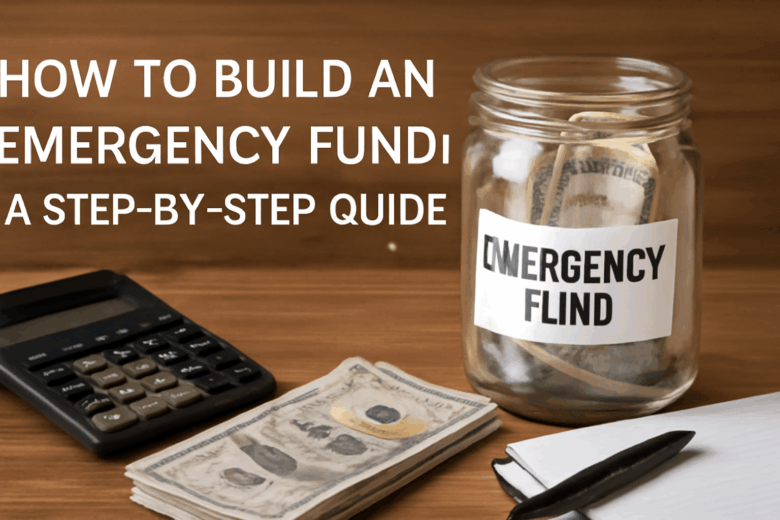Life is full of surprises—some good, some challenging. Whether it’s an unexpected medical bill, job loss, or urgent home or car repair, having an emergency fund can make a significant difference in how you handle those situations. Instead of relying on credit cards or loans, you’ll have a financial cushion to help you get through tough times without going into debt.
This article will walk you through the step-by-step process of building a reliable emergency fund, even if you’re starting from zero.
What Is an Emergency Fund?
An emergency fund is a dedicated savings account meant to cover unforeseen and urgent expenses. It’s not meant for planned spending like vacations or a new phone—it’s a safety net designed for real emergencies.
Examples of what it should cover:
- Job loss or reduced work hours
- Medical emergencies or unexpected health expenses
- Emergency home or car repairs
- Sudden travel needs due to family issues
Why You Need an Emergency Fund
Having a well-stocked emergency fund gives you:
- Peace of mind, knowing you’re prepared for the unexpected
- Protection against debt, since you won’t have to borrow during a crisis
- Financial stability, especially during uncertain times like a recession or global crisis
Without an emergency fund, a single unexpected expense can derail your finances and lead to stress, anxiety, and high-interest debt.
Step 1: Set a Realistic Savings Goal
Your first step is figuring out how much to save. Financial experts generally recommend saving between 3 to 6 months’ worth of essential expenses.
To estimate your goal:
- List your monthly essentials like rent/mortgage, utilities, groceries, transportation, and insurance.
- Multiply that number by 3 to 6 to get your target.
Example:
If your monthly essentials cost $2,000, aim for an emergency fund of $6,000–$12,000.
If that feels overwhelming, don’t worry. Start with a mini emergency fund of $500 to $1,000 to give you some breathing room while you build toward the full amount.
Step 2: Open a Separate Savings Account
Your emergency fund needs to be:
- Accessible, so you can get to the money quickly in a true emergency
- Separate, so you’re not tempted to spend it on non-emergencies
- Safe, so you don’t risk losing it to market volatility
The best option is a high-yield savings account—it earns more interest than a regular savings account and keeps your funds safe and liquid.
Avoid investing your emergency fund in the stock market. It should be low-risk and easily available.
Step 3: Make Saving Automatic
Consistency is key. Automating your savings removes the mental load and makes it easier to build your emergency fund over time.
Ways to automate:
- Set up a recurring monthly transfer from your checking to your savings account
- Use apps or tools that round up purchases and save the difference
- Direct a portion of each paycheck into your emergency fund if your employer allows split deposits
Even if it’s just $25 or $50 per paycheck, that money adds up faster than you think.
Step 4: Start Small and Increase Over Time
Don’t feel discouraged if you can’t save large amounts right away. Start with whatever you can afford and increase contributions as your financial situation improves.
Strategies to get started:
- Save your tax refund or work bonus
- Use cash-back rewards or rebates to fund your savings
- Sell unused items around your home and deposit the earnings
Focus on building the habit of saving. Once that habit is strong, the fund will grow naturally.
Step 5: Cut Back on Non-Essential Spending
One of the quickest ways to grow your emergency fund is to temporarily reduce discretionary spending.
Ideas to free up money:
- Cook meals at home instead of eating out
- Cancel unused subscriptions or streaming services
- Set a monthly limit on shopping or entertainment
- Look for lower-cost options on phone, internet, or insurance plans
Then take the money you save and move it directly into your emergency fund.
Step 6: Keep It for Real Emergencies Only
Once your fund starts growing, it might be tempting to dip into it for everyday expenses or non-urgent wants—but resist that urge.
What’s not an emergency:
- Holiday shopping
- A vacation
- A new phone or TV
- Home decor upgrades
Stick to the rule: If it’s unexpected, urgent, and necessary, then it qualifies as an emergency.
Step 7: Replenish After Use
If you ever need to use your emergency fund, that’s okay—that’s what it’s for. Just make it a priority to rebuild the balance as soon as possible.
You can do this by:
- Resuming automated contributions
- Temporarily increasing your savings rate
- Allocating windfalls or extra income back into the fund
Think of it like insurance—once used, it needs to be refilled for future protection.
Step 8: Review Your Fund Annually
As your life changes, so should your emergency fund. Review it at least once a year or whenever you experience a significant life change, such as:
- Getting married or having a child
- Moving to a more expensive city
- Changing jobs or careers
- Increasing or decreasing your monthly expenses
Make sure your emergency fund is aligned with your current needs and lifestyle.
Building an emergency fund doesn’t have to be overwhelming. Even if you start small, the most important thing is to start.
By creating a separate account, setting realistic goals, and committing to regular contributions, you’re taking control of your financial future. It’s one of the smartest and most empowering financial moves you can make.
No one can predict life’s emergencies—but with the right plan in place, you can face them with confidence and security.
Start building your emergency fund today—your future self will thank you.




